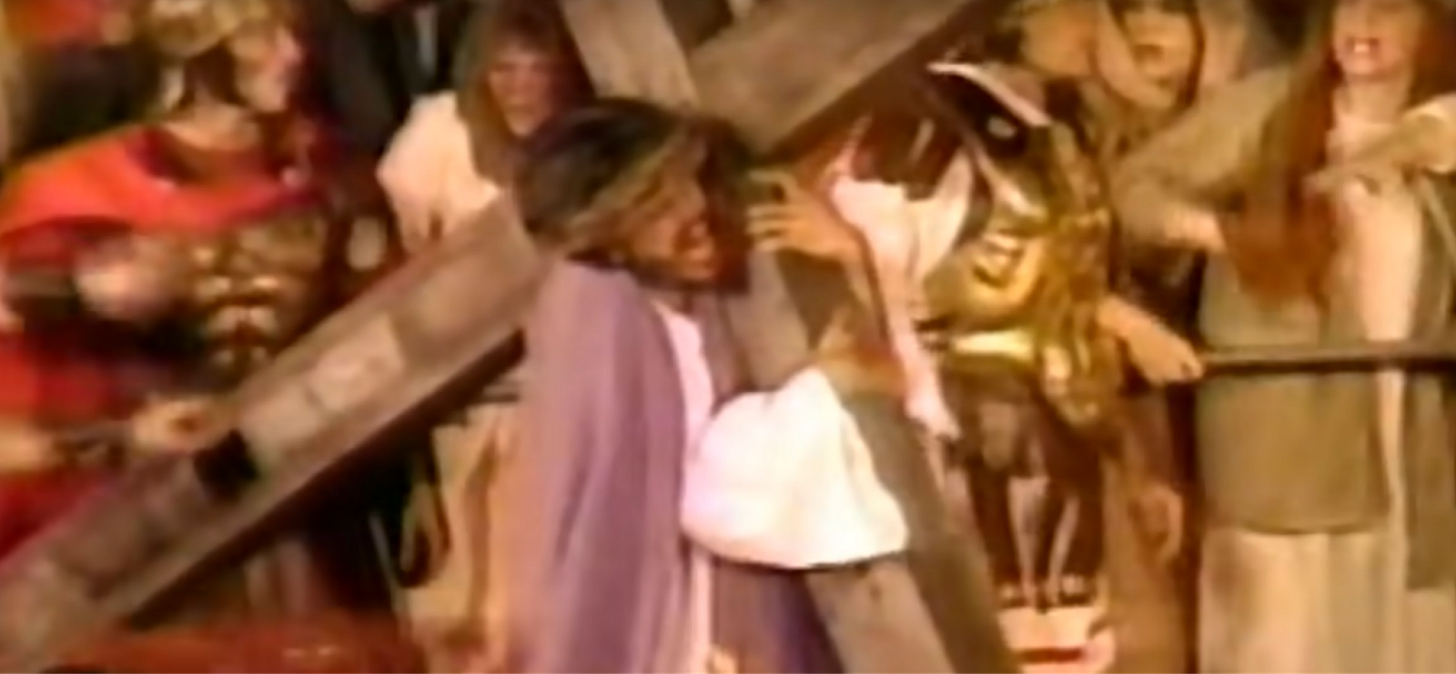The Rise & Fall of Christian Disneyworld
or, dissection of a fraud
The seed of today's post, from which all the chaos sprouts, is an idea: Christian Disney World. It is, commercially speaking, a really good idea. If there are two things Americans love, it's God and consumerism. Why not bundle them? No venture capitalist worth their salt would pass on that, especially if Jim Bakker pitched the idea.
Jim Bakker, alongside his wife Tammy, did pitch this idea beginning in the 1970s. Over 1,000 investors saw the potential and piled on. For a decade, those investors must have been thrilled. In 1986, six million people trekked to Fort Mill, South Carolina to visit Heritage USA, aka Christian Disney World, making it America's third largest theme park, behind only the two Disneys. Then, everything fell apart. By 1990, the park was shuttered and Jim Bakker was in prison. Investors lost everything. Decades later, the site is a holy ghost town riddled with rusting religious paraphernalia and dilapidated chapels, fodder for a Tim Burton film. The story of Heritage USA is worth knowing, not just for the drama, but because it offers the opportunity to dissect a fraud.
Background: The Bakkers & PTL Club
In 1961, Jim Bakker and Tammy Faye Lavalley dropped out of their Minneapolis Bible College to get married and become itinerant preacher-puppeteers (that was a weird sentence to write). They traveled around the country for five years before returning to Minneapolis, where Tammy got a job working for the Christian Broadcasting Network. Today, the Christian Broadcast Network, which airs "The 700 Club," reaches 97% of US households and has almost a million daily viewers. At that time, though, the network had just started. The Bakkers filled airtime with a makeshift puppet show. They caught the eye of a few Christian TV networks and had a couple of brief stints as on-air shows. In 1976, the Bakkers launched their own network, PTL, and hosted the flagship show "PTL Club." "PTL Club" was a cross between "The Tonight Show," "Blue's Clues," and a Papal Liturgy. The Bakkers would host a series of conversations and stunts in front of a live audience. It was late-night TV for Christians, and it worked:
The PTL network (short for Praise the Lord) was organized as a non-profit ministry. Viewers, in an early form of televangelism, were encouraged to donate to the ministry. The ministry, in turn, promised to keep producing Christian content and use any excess donations to evangelize and do good (spoiler alert: they didn't do that second part). By the end of the 1970s, the ministry was pulling in $1 million per week from viewers, far in excess of what it needed. While the Bakkers would publicly commit large sums to orphanages in Brazil or US prison ministries or a network of PTL food banks (most of which, again, never happened), they really had their eyes on something bigger, more fantastical: Christian Disneyland.
Launch of Heritage USA
From a business perspective, Heritage USA was a natural market expansion for PTL. PTL was a media company that developed content based around personalities, and the first way to monetize that content was the traditional media way: merchandising, advertising, and otherwise soliciting money from viewers. Next, PTL wanted to stretch its intellectual property wider, offer a new way for its fanbase to engage. For inspiration, The Bakker’s had to look no further than Disney, the ultimate IP (intellectual property) company. Disney World and Disneyland were not just revenue generators, they deepened the fan’s connection to the content. This was literally Walt Disney’s original blueprint for his business:

The Bakker’s saw that they too could empower their whole operation by building a theme park. They named their idea Heritage USA and began soliciting loans from investors, loans that would ultimately drive them to bankruptcy. At this point the Bakkers had siphoned enough money out of PLT to be ultra-wealthy in their own right, but probably not rich enough to build a theme park themselves. At the time of its collapse, the property, buildings, and assets of Heritage USA were valued at over $100 million (more than $300 million in today’s dollars). Instead of self-funging, then, the Bakker’s found over 1,000 investors, ranging from construction firms that would build on credit to TV networks that had previously partnered with PLT, to foot the bill for Heritage USA. In 1978, just a few years after conceiving the idea, Heritage USA punched its first admission ticket.
Building a theme park is no small feat, let alone building a wildly successful one. The Bakkers did just that, and they did it fast as hell and with great fanfare. The failure rate is high for media businesses looking to expand into new areas. Look at CNN+ (canceled before launch), the Mortal Kombat movies, any of the 1,000 abandoned theme parks in North America, or that line of Teletubby handguns (image not found). Sometimes intellectual property doesn’t translate to new formats. So the Bakkers deserve credit for masterminding the PLT launch of Heritage USA. It was top-notch management of a media company. The problem is that PLT wasn’t supposed to be a media company. It was registered as a 501c3 not-for-profit ministry. PLT wasn’t paying taxes because all its income was supposed to support its faith-based mission. In actuality, it was supporting the Bakker’s (admittedly baller) lifestyle. The Bakkers also had this habit, dating back to the early days of PLT, of lying to investors. They’d borrow a million bucks, allegedly to build a hotel or a new ride, but never do it. That is fraud, in no uncertain terms. That all comes later. First came the roaring success of Christian Disneyworld.
What was Heritage USA actually like?
Heritage USA was a first-class retreat where Christians could have fun without being tempted by the devil (in Jim Bakker's words). Ironically, Bakker would later be indicted for using PTL ministry funds to buy himself an $800 Gucci suitcase, and what is the devil's temptation if not an $800 Gucci suitcase? For those wondering how fun is possible without temptation, consider the Heritage USA water park. It was awesome:
The rest of Heritage USA's 2,300 acres (Disneyland is 500 acres, for reference) included hotel rooms, campsites, a fluffed-up Main Street with shopping, an amphitheater for shows, churches (obviously), and other typical theme park attractions. The childhood home of preacher Billy Graham was uprooted and plopped in their park (it's unclear who the target market was for that). The real showstopper, though, was the daily Vegas-style reenactment of the Crucifixion. The performance looked like something Criss Angel would put on if he were working off a debt to the Pope:
It was heaven in literally the last place you’d expect it: 25 minutes south of Charlotte.
Was Heritage USA Profitable?
In 1986, six million people came to Heritage USA, making it the third largest theme park in America. The park was free to enter, but attractions cost money (water park entrance was $10), and hotel accommodations could run over $100 per night (much less for campers/RV). Even with six million visitors, it's unlikely the park could ever be standalone profitable with that pricing model. However, PTL ministries, through its televangelism, was bringing in millions of dollars per week in donations, most of which was rerouted to Heritage USA (and from there, to Bakker's pockets). Apparently, that still wasn't enough. In 1968, Heritage USA offered lifetime memberships. For a $1,000 payment, anyone could buy perpetual rights to stay four nights at a Heritage USA hotel. Pay now, salvation vacations forever! Over 160,000 people bought the membership, a total windfall for the entire PTL organization. The money was allegedly to be used to further develop the park, but that never happened.
The downfall of Heritage USA
PTL was obviously not a non-profit ministry. PTL, and its Heritage USA theme park, were for-profit ventures meant to enrich the Bakkers. This was no secret. In 1979, just three years after Bakker started the PTL network, the Federal Communications Commission (FCC) investigated and fined PTL for lying about the use of donated money. Bakker, though, flipped the script. He described the charges as "satanic attacks from the federal government" and vowed to "fight to the day I die for the right to broadcast the gospel of Jesus Christ over the airwaves." Viewers bought it. The FCC's charges brought attention to Bakker. With his rallying call to "give the Devil a black eye," he leveraged that attention to multiply the influence of his platform. PTL's reported revenues were $28 million in 1978; they were $128 million just a few years later, after the fine. In a lot of ways, the Heritage USA theme park never would have happened if the FCC didn't try to shut PTL down! No doubt, the FCC failed to stop the Bakkers. The IRS, though, was also following PTL closely. Remember, PTL wasn't paying taxes because of its non-profit status. As is often the case, it takes years for the IRS to build a complex tax fraud case. PTL's lifetime memberships were the breakthrough piece. In 1985, the IRS recommended revoking PTL's tax-exempt status because the lifetime memberships being offered were actually timeshares, a for-profit activity that non-profits cannot engage in. The IRS investigation gained steam from there, but they weren't the only ones scrutinizing Bakker's behavior. In 1987, the Charlotte Observer broke a huge story: Bakker had used PTL money to wire $279,000 to his former secretary after he allegedly had drugged and sexually assaulted her. Bakker denied the sexual allegations but admitted to an affair. The scandal was so overwhelming that Bakker had to step aside from PTL, at least temporarily. He arranged for his friend and fellow televangelist Jerry Falwell (no stranger to prosperity gospel or scandals) to take over. Falwell agreed. Shortly after taking over, Falwell even arranged an emergency fundraiser (donations were drying up and bills were piling) by going down Heritage USA's biggest water slide in a suit:
However, Falwell quickly turned on Bakker. In April 1987, months after taking over, Falwell revealed that $92 million in PTL funds was missing and accused the Bakkers of impropriety. He fired most of the management team of PTL, including the Bakkers. Now, no one can say with absolute certainty what happened to that $92 million, but anyone can say with reasonable certainty that the Bakkers stole it. Why? Well, the IRS doubled down on its allegations and revealed that the Bakkers had been paid over $10 million in personal payments (10x more than they reported) and that PTL had ceased funding to pretty much all its non-profit missions. Instead, PTL paid for the Bakkers' million-dollar condo, their anniversary trip to Hawaii, $67,000 in women's clothes, that $800 Gucci briefcase, cars, furs, and many other things. The final nail in the coffin was when the IRS demanded $42 million in back taxes from PTL. In 1987, unable to pay back the IRS, PTL declared bankruptcy.
What happened to PTL & Heritage USA?
PTL Ministries, the non-profit parent organization through which the Bakkers ran their fraud, went into a complex bankruptcy that took decades to settle and left everyone unsatisfied except the well-compensated lawyers. That's how bankruptcies go. Jerry Falwell, who took over during the scandal, didn't last long as CEO. There wasn't much he could do once he uncovered the massive fraud, and he resigned quickly. Despite the Bakkers having robbed the ministry blind, there were still two valuable assets on the table: the PTL Club TV show and the Heritage USA theme park. These two parts of the business were genuinely thriving - not uncommon in fraudulent cases (Enron and Worldcom had this characteristic as well). Shockingly, or maybe not shocking but just sad, the PTL Club continued to air and receive donations from viewers. Jerry Falwell temporarily hosted, but after he quit, a new host, Sam Johnson, took over. The show was canceled in 1989 only after Sam Johnson also got in trouble with the IRS. Again, maybe not shocking but disheartening. The Heritage USA theme park, valued at $129 million in the bankruptcy filing, also shuttered quickly. The park may have been financially salvageable, but the entire operation was tainted by the scandal. Running that park was like trying to sell a perfectly good bushel of apples when everyone knows the apples come from a sewage-irrigated orchard. The property has since been sold off for parts, and a condominium now stands where Heritage Main Street used to be. Mostly though, the park is abandoned and serves as a derelict playground for YouTubers to explore. Its potential as a world-class haunted house goes untapped.
What became of the Bakker’s?
First, on Tammy. Tammy Bakker was never charged or prosecuted with any wrongdoing. She certainly benefited from the fraud, and she indulged in a degree of materialism that some might find unbecoming of a preacher, such as buying gold-plated toilets and asking viewers to pray for her to get a swimming pool. She was, however, a proponent of the gospel prosperity movement, and it's plausible that she viewed materialism as a form of piety. While her legacy is tainted by her involvement with PTL, it is still redeemable. In the 1980s, few Fundamentalist Christian preachers were as outspoken in their support for the LGBTQ+ community as Tammy Bakker, who even became a reality TV star on VH1's The Surreal Life after the scandal. A biopic of her life came in 2021.
Jim Bakker, on the other hand, is irredeemable. He was indicted for wire fraud in 1987, shortly after the sexual assault and fraud scandals broke out. Despite pleading not guilty, he was convicted in a case that the district attorney called "by far and away the easiest fraud case I ever prosecuted." The judge sentenced him to over 40 years in prison. It's hard to feel sorry for someone who literally robbed orphanages, and justice was served - or so it seemed. Bakker retained the same lawyer who would later defend O.J. Simpson and appealed his sentence, and he won. He was released in 1994 after serving just five years. He immediately returned to the air with a new show and ministry, with a twist: he now presents himself as an apocalyptic televangelist preacher. Bakker has made headlines for the kinds of antics that one might expect from him, such as blaming a hurricane on Obama's alleged godlessness, claiming to have prophesied the 9/11 attacks (though he didn't mention it until after the fact), and most recently, peddling medical supplements that he claimed could cure COVID. In a memoir published in the 1990s, he admitted that the first time he actually read the Bible was in prison - a fact that he had never mentioned during his decades as a televangelist. Bakker is still on the air, still defrauding the most vulnerable members of society, and has contributed nothing of value to the general welfare. On the bright side, he has provided the world with plenty of meme-worthy content:
As a final twist, Bakker has raised millions of dollars from new investors, including $17 million for a large plot of land on which he plans to build something reminiscent of Heritage USA. This unsatisfying conclusion to the story illustrates the unfortunate reality that fraudsters and con artists sometimes operate successful businesses, that authorities may be unable to stop them, and that the bad guys can sometimes get a second chance. If there's a sucker born every minute, then there's a Jim Bakker getting out of jail every hour. It pays to be skeptical.







